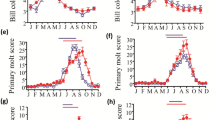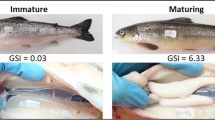Abstract
Day length regulates annual reproductive cycle in many birds including subtropical Indian Weaver birds (Ploceus philippinus). We investigated whether light intensity modulated the effects of the duration of photoperiod in inducing testicular recrudescence- regression cycle, and whether such effects are influenced by the seasons. Two experiments were performed in which Weaver birds were exposed to near threshold and long photoperiods at different light intensities at two times of the year. In experiment 1, Weaver birds were exposed to 11.5 L:12.5 D, 12 L:12 D and 13 L:11 D photoperiods with light intensity 0.04 and 3.4 Wm−2 for a period of 40 weeks, beginning in May (pre-breeding season). Experiment 2 compared light intensity effects on photoperiodic induction in two different seasons, and differed from the experiment 1 in using a different grade of light intensities. Weaver birds were exposed to 11.5 L:12.5 D, 12 L:12 D and 13 L:11 D at 0.05 and 2.1 Wm−2 light intensity for 24 weeks, beginning in April (pre-breeding season) and September (post-breeding season). Observations on testis size and wing primaries molt were recorded weekly (molt) or at 4-week intervals (testes). There was a significant effect of light intensity on photoperiodic induction of testicular growth in birds exposed to 13 h, but not to 11.5- and 12 h photoperiods. Further, testis recrudescence under a stimulatory photoperiod was faster in birds exposed during pre-breeding, compared to post-breeding. Thus, light intensity influences the rate of testicular maturation and molt, but does not alter the critical day length for photoperiodic induction in Indian Weaver birds. This may be adaptive for birds in using light intensity to modulate the rates of their physiological processes as needed in the wild.
Zusammenfassung
Lichtintensität verändert die stimulierenden Effekte langer Photoperioden, verändert aber nicht die kritische Photoperiode bei Indischen Webervögeln ( Ploceus philippinus )
Die Tageslänge reguliert den jährlichen Reproduktionszyklus vieler Vogelarten inklusive subtropischer indischer Webervögel (Ploceus philippinus). Wir untersuchten, inwiefern die Lichtintensität die Effekte der Länge der Photoperiode hinsichtlich der Induzierung des testikulären Aufbau- und Rückbildungszyklus modifiziert und ob solche Effekte von den Jahreszeiten beeinflusst werden. Zwei Experimente wurden durchgeführt, bei denen Webervögel nahe dem Schwellenwert und langen Photoperioden bei unterschiedlichen Lichtintensitäten zu zwei unterschiedlichen Zeiten im Jahr ausgesetzt wurden. In Experiment 1 wurden Webervögel 11.5 L: 12.55 D, 125 L: 125 D und 135 L: 115 D Photoperioden mit Lichtintensitäten von 0.04 und 3.4 Wm−2 über einen Zeitraum von 40 Wochen ab Anfang Mai (Vorbrutphase) ausgesetzt. Experiment 2 vergleicht die Effekte der Lichtintensität auf die photoperiodische Induzierung zu zwei verschiedenen Jahreszeiten und unterscheidet sich von Experiment 1 im unterschiedlichen Grad der Lichtintensitäten. Webervögel wurden 11.55 L:12.55 D, 125 L:125 D und 135 L:115 D bei Lichtintensitäten von 0.05 und 2.1 Wm−2 über 24 Wochen im April (Vorbrutzeit) und im September (Nachbrutzeit) ausgesetzt. Hodengröße und Handschwingenmauser wurden wöchentlich (Mauserstadium) oder 4-wöchentlich (Hoden) erfasst. Es gab einen signifikanten Effekt der Lichtintensität auf die photoperiodische Induzierung des Hodenwachstums bei Vögeln, die 13 Stunden, aber nicht 11,5 und 12 Stunden Tageslänge hatten. Darüber hinaus erfolgte das Hodenwachstum unter stimulierender Photoperiode schneller bei Vögeln in der Vorbrutzeit im Vergleich zur Nachbrutzeit. Damit beeinflusst die Lichtintensität die Rate der testikulären Reifung und Mauser, verändert jedoch nicht die entscheidende Tageslänge für eine photoperiodische Induzierung bei Webervögeln. Dies könnte eine Anpassungsfähigkeit von Vögeln sein, die die Lichtintensität nutzen, um das Tempo ihrer physiologischen Prozesse entsprechend zu modifizieren.


Similar content being viewed by others
References
Ali S, Ripley SD (1974) Handbook of birds of India and Pakistan (2nd edn). Oxford University Press, New York
Bentley GE, Goldsmith AR, Dawson A, Briggs C, Pemberton M (1998) Decreased light intensity alters the perception of day length by male European starlings (Sturnus vulgaris). J Biol Rhythms 13:148–158
Budki P, Rani S, Kumar V (2009) Food deprivation during photosensitive and photorefractory life-history stages affects the reproductive cycle in the migratory red-headed bunting (Emberiza bruniceps). J Exp Biol 212:225–230
Budki P, Rani S, Kumar V (2012) Persistence of circannual rhythms under constant periodic and aperiodic light conditions: sex differences and relationship with the external environment. J Exp Biol 215:3774–3785
Budki P, Malik S, Rani S, Kumar V (2014) Circadian rhythms are not involved in the regulation of circannual reproductive cycles in a sub-tropical bird, the spotted munia. J Exp Biol 217:2569–2579
Chakravorty K, Chandola A (1985) Termination of seasonal breeding in a weaver finch, Ploceus philippinus: role of photoperiod. J Exp Zool 235:381–386
Chandola A, Chakravorty K (1982) Termination of seasonal breeding in the photoperiodic weaver bird. J Exp Zool 222:169–172
Dawson A, King VM, Bentley GE, Ball GF (2001) Photoperiodic control of seasonality in birds. J Biol Rhythms 16:365–380
Donham RS, Moore MC, Farner DS (1983) Physiological basis of repeated testicular cycles on twelve-hour days (12 L:12 D) in white-crowned sparrows, (Zonotrichia leucophrys gambelii). Physiol Zool 56:302–307
Farner DS, Donham RS, Matt KS, Mattocks PW, Moore MC, Wingfield JC (1983) The nature photorefractoriness. In: Mikami S, Homma K, Wada M (eds) Avian Endocrinology: environmental and ecological perspective. Springer, Berlin, pp 149–166
Follett BK, Maung SL (1978) Rate of testicular maturation, in relation to gonadotrophin and testosterone levels, in quail exposed to various artificial photoperiods and to natural day lengths. J Endocrinol 78:267–280
Gwinner E, Scheuerlein A (1998) Seasonal changes in day-length intensity as a potential zeitgeber of circannual rhythms in equatorial stonechats. J Ornithol 139:407–412
Kumar V (1997) Photoperiodism in higher vertebrates—An adaptive strategy in temporal environment. Ind J Exp Biol 35:427–437
Kumar BS, Anushi (2004) The effect of duration and time of food availability on the photoperiodic response in the male house sparrow, Passer domesticus. Reprod Nutr Dev 44:29–35
Kumar V, Kumar BS (1991) The development of photorefractoriness in termination of the breeding season in the tropical brahminy myna: role of photoperiod. Reprod Nutr Dev 31:27–36
Kumar BS, Kumar P (2004) Photosensitivity in body mass and testicular activity of brahminy myna, Sturnus pagodarum. Reprod Nutr Dev 44:365–369
Kumar V, Singh S, Misra M, Malik S (2001) Effects of duration and time of food availability on photoperiodic responses in the migratory male blackheaded bunting (Emberiza melanocephala). J Exp Biol 204:2843–2848
Misra M, Rani S, Singh S, Kumar V (2004) Regulation of seasonality in the migratory male blackheaded bunting (Emberiza melanocephala). Reprod Nutr Dev 44:341–352
Morton ML, Pereyra ME, Baptista LF (1985) Photoperiodically induced ovarian growth in the white crowned sparrow (Zonotrichia leucophrys gambelii) and its augmentation by song. Biochem Physiol A 80:93–97
Nakane Y, Ikegami K, Ono H, Yamamoto N, Yoshida S, Hirunagi K, Ebihara S, Kubo Y, Yoshimura T (2010) A mammalian neural tissue opsin (Opsin 5) is a deep brain photoreceptor in birds. Proc Natl Acad Sci USA 107:3415264–3415268
Nicholls TJ, Goldsmith AR, Dawson A (1988) Photorefractoriness in birds and comparison with mammals. Physiol Rev 68:133–176
Rani S, Singh S, Misra M, Malik S, Singh BP, Kumar V (2005) Daily light regulates seasonal responses in the migratory male redheaded bunting (Emberiza bruniceps). J Exp Zool 303A:541–550
Singh S, Chandola A (1981) Photoperiodic control of seasonal reproduction in tropical weaver bird. J Exp Zool 216:293–298
Singh S, Chandola A (1982) Seasonal variation in photogonadal response of the tropical weaver bird. Gen Comp Endocrinol 48:123–129
Trivedi AK, Rani S, Kumar V (2006) Control of annual reproductive cycle in the subtropical house sparrow (Passer domesticus): evidence for conservation of photoperiodic control mechanisms in birds. Front Zool 3:12
Acknowledgments
The study was funded by generous research grants from the Department of Science and Technology, New Delhi, India through research funding (SR/SO/AS-36/2006 and SR/SO/AS-70/2011) to SKB. We also thank Chief Wildlife Warden, Department of Forests and Wildlife, Lucknow, Uttar Pradesh for permitting us to work on this species.
Ethical standard
The experiments were carried out as per approval and guidelines of Institutional Animal Ethics Committee (IAEC), Department of Zoology, Ch. Charan Singh University, Meerut, India.
Author information
Authors and Affiliations
Corresponding author
Additional information
Communicated by L. Fusani.
Rights and permissions
About this article
Cite this article
Bhardwaj, S.K., Pandey, R.K. Light intensity alters the stimulatory effects of long photoperiod, but does not alter critical photoperiod in the Indian Weaver Bird (Ploceus philippinus). J Ornithol 156, 223–229 (2015). https://doi.org/10.1007/s10336-014-1118-9
Received:
Revised:
Accepted:
Published:
Issue Date:
DOI: https://doi.org/10.1007/s10336-014-1118-9




